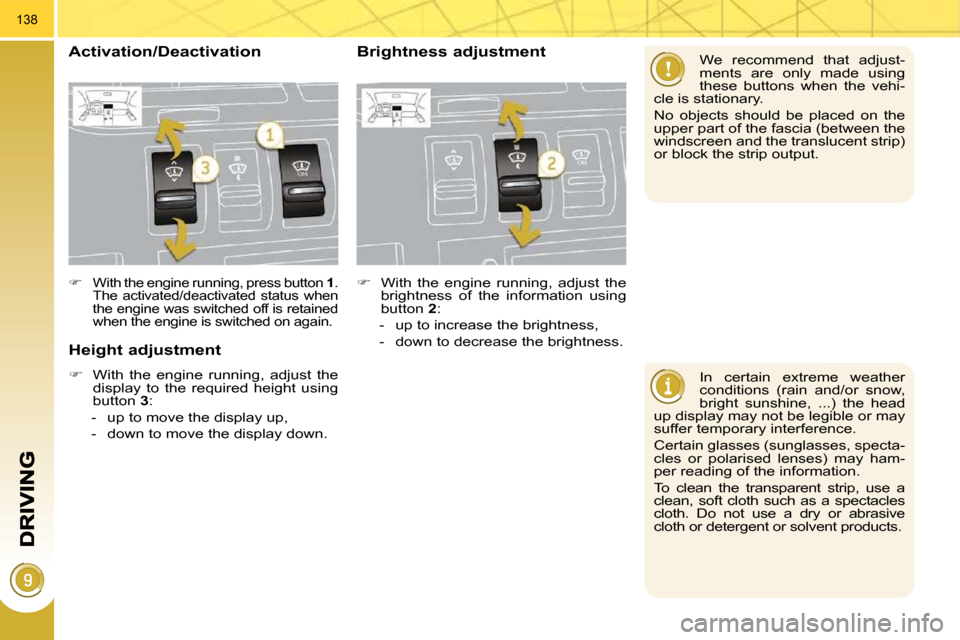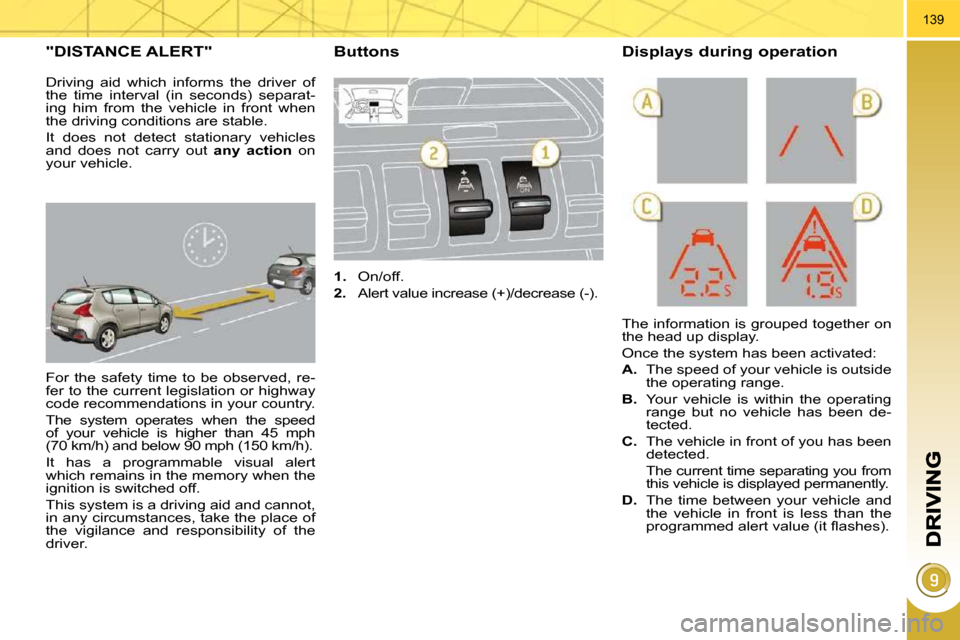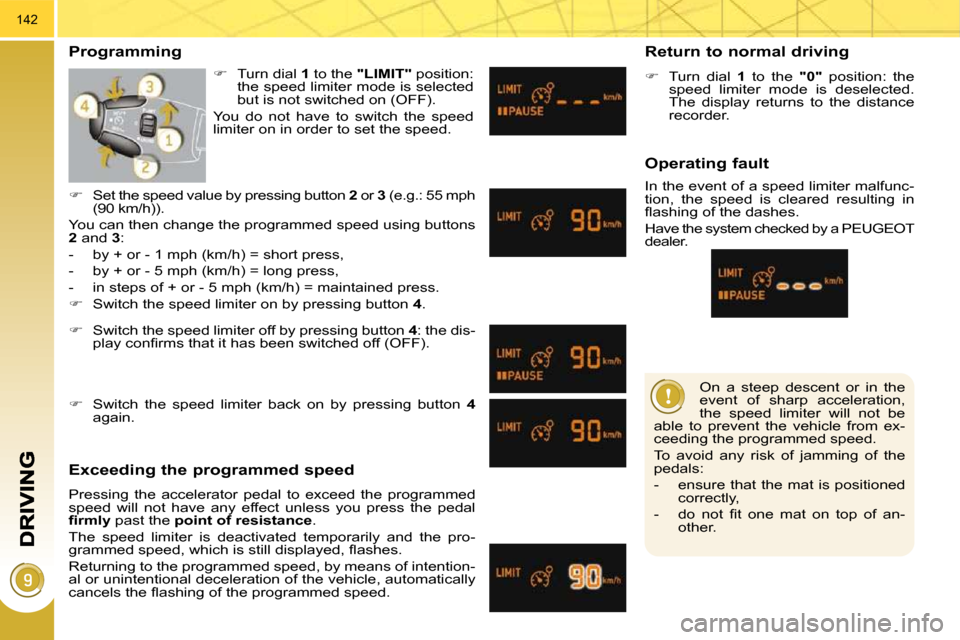2009.5 Peugeot 3008 Dag display
[x] Cancel search: displayPage 136 of 290

132
Particular situations
In certain situations (e.g. start-
ing the engine), the parking brake
can automatically alter its force. This
is normal operation.
Emergency braking
In the event of a failure of the braking by
means of the brake pedal or in an ex-
ceptional situation (e.g. driver taken ill,
under instruction, etc) a continuous pull
on control A will stop the vehicle.
The electronic stability programme
(ESP) provides stability during emer-
gency braking.
If the emergency braking malfunctions,
one of the following messages will be
displayed:
- "Parking brake faulty".
- "Parking brake control faulty".
To advance your vehicle a few cen-
timetres without starting the engine,
but with the ignition on, press on the
brake pedal and release the parking
brake
by pulling then releasing con-
trol A . The full release of the parking
�b�r�a�k�e� �i�s� �c�o�n�fi� �r�m�e�d� �b�y� �t�h�e� �e�x�t�i�n�c�t�i�o�n�
of warning lamp on control A and of
the warning lamp on the instrument
panel and the displaying of the mes-
sage "Parking brake released".
If the parking brake malfunctions
while applied or if the battery runs
�fl� �a�t�,� �a�n� �e�m�e�r�g�e�n�c�y� �r�e�l�e�a�s�e� �i�a� �a�l�w�a�y�s�
possible. If a failure of the ESP system
is signalled by the lighting of
this warning lamp, then brak-
ing stability is not guaranteed.
In this event, stability must be assured
by the driver by repeating alternate "pull
release" actions on control A .
The emergency braking must
only be used in exceptional
circumstances.
Page 139 of 290

137
System which projects various informa-
�t�i�o�n� �o�n�t�o� �a� �t�r�a�n�s�p�a�r�e�n�t� �s�t�r�i�p� �i�n� �t�h�e� �fi� �e�l�d�
of vision of the driver so that he does
not have to take his eyes off the road.
This system operates when the engine
is running and the settings are stored
when the ignition is switched off.
HEAD UP DISPLAY
1. Head up display on/off.
2. Brightness adjustment.
3. Display height adjustment.
The strip is activated by pressing one of
the buttons. Once the system has been activated,
the following information is grouped to-
gether on the head up display:
A. The speed of your vehicle.
B. The cruise control/speed limiter in-
formation.
C. The "distance alert" information.
Buttons Displays during operation
Page 140 of 290

138
In certain extreme weather
conditions (rain and/or snow,
bright sunshine, ...) the head
up display may not be legible or may
suffer temporary interference.
Certain glasses (sunglasses, specta-
cles or polarised lenses) may ham-
per reading of the information.
To clean the transparent strip, use a
clean, soft cloth such as a spectacles
cloth. Do not use a dry or abrasive
cloth or detergent or solvent products. We recommend that adjust-
ments are only made using
these buttons when the vehi-
cle is stationary.
No objects should be placed on the
upper part of the fascia (between the
windscreen and the translucent strip)
or block the strip output.
� With the engine running, press button 1 .
The activated/deactivated status when
the engine was switched off is retained
when the engine is switched on again.
Height adjustment
� With the engine running, adjust the
display to the required height using
button 3 :
- up to move the display up,
- down to move the display down.
Activation/Deactivation Brightness adjustment
� With the engine running, adjust the
brightness of the information using
button 2 :
- up to increase the brightness,
- down to decrease the brightness.
Page 141 of 290

139
"DISTANCE ALERT"
For the safety time to be observed, re-
fer to the current legislation or highway
code recommendations in your country.
The system operates when the speed
of your vehicle is higher than 45 mph
(70 km/h) and below 90 mph (150 km/h).
It has a programmable visual alert
which remains in the memory when the
ignition is switched off.
This system is a driving aid and cannot,
in any circumstances, take the place of
the vigilance and responsibility of the
driver.
1. On/off.
2. Alert value increase (+)/decrease (-).
The information is grouped together on
the head up display.
Once the system has been activated:
A. The speed of your vehicle is outside
the operating range.
B. Your vehicle is within the operating
range but no vehicle has been de-
tected.
C. The vehicle in front of you has been
detected.
The current time separating you from this vehicle is displayed permanently.
D. The time between your vehicle and
the vehicle in front is less than the
�p�r�o�g�r�a�m�m�e�d� �a�l�e�r�t� �v�a�l�u�e� �(�i�t� �fl� �a�s�h�e�s�)�.� � �
Buttons Displays during operation
Driving aid which informs the driver of
the time interval (in seconds) separat-
ing him from the vehicle in front when
the driving conditions are stable.
It does not detect stationary vehicles
and does not carry out any action on
your vehicle.
Page 142 of 290

140
Activation
Deactivation
� Press button 1 to deactivate the sys-
tem, the indicator light switches off.
Reactivation
� Press button 1 again to reactivate
the system.
The last value programmed is retained and the indicator light comes on.
If the indicator light on but-
ton 1� � �fl� �a�s�h�e�s�,� �h�a�v�e� �t�h�e� �s�y�s�-
tem checked by a PEUGEOT
dealer.
Operating limits
The system switches to standby auto-
matically if the sensor does not detect
�t�h�e� �v�e�h�i�c�l�e� �i�n� �f�r�o�n�t� �c�o�r�r�e�c�t�l�y� �(�v�e�r�y� �d�i�f�fi� �-
cult weather conditions, sensor misad-
justed, ...). A message is displayed on
the multifunction display.
The vehicle being followed may not be
detected in certain conditions such as,
for example:
- when turning,
- when changing lane,
- when the vehicle in front is either too far ahead (maximum range of
the sensor: 100 m) or stationary (in
�a� �t�r�a�f�fi� �c� �j�a�m�,� �.�.�.�)�,� �
When the vehicle being followed is ex-
cessively near (time between the two
vehicles less than 0.5 seconds), the dis-
�p�l�a�y� �r�e�m�a�i�n�s� �fi� �x�e�d� �a�t� �0�.�5� �s�e�c�o�n�d�s�.�
Programming the alert value
� Select the alert value required using
button 2 , in steps of 0.1 second:
- up to increase: "+",
- down to decrease: "-".
Example with a value of 2 seconds:
This system is not an anti-collision
radar and it does not act of the move-
ment of your vehicle. It is informative
and cannot, in any circumstances,
take the place of the vigilance and
responsibility of the driver.
� Press button 1 , the indicator light
comes on.
The system is activated but will only op-
erate from 45 mph (70 km/h).
The alert value can be programmed to
between 0.9 second and 2.5 seconds.
The visual alert can be deactivated by
programming a value of 0 second. When the time (in seconds) between
your vehicle and the vehicle in front is
less than the programmed time (alert
�v�a�l�u�e�)�,� �a� �v�i�s�u�a�l� �a�l�e�r�t� �fl� �a�s�h�e�s�.�
A safety time of 2 seconds is
recommended in normal driv-
ing conditions (correct traction
and speed) to avoid a collision
in the event of emergency braking.
Page 143 of 290

141
SPEED LIMITER
System which prevents the vehicle from
exceeding the speed programmed by
the driver.
When the programmed speed limit is
reached, pressing the accelerator pedal
no longer has any effect. The controls of this system are grouped
together on stalk A .
1. Speed limiter mode selection dial
2. Programmed value decrease button
3. Programmed value increase button
4. Speed limiter on/off button
The programmed information is grouped
together on the instrument panel dis-
play.
5. Speed limiter on/off indication
6. Speed limiter mode selection indica-
tion
7. Programmed speed value
Steering wheel controls Displays on the instrument panel
The speed limiter cannot, in any
circumstances, replace the need
to respect speed limits, nor can
it replace the need for vigilance and re-
sponsibility on the part of the driver.
The speed limiter is
switched on man-
ually: it requires a programmed speed
of at least 20 mph (30 km/h).
The speed limiter is switched off by
manual operation of the control.
The programmed speed can be ex-
ceeded temporarily by pressing the ac-
�c�e�l�e�r�a�t�o�r� �fi� �r�m�l�y�.�
To return to the programmed speed,
simply slow down to a speed below the
programmed speed by releasing the ac-
celerator.
The programmed speed remains in the
memory when the ignition is switched off.
This information is also dis-
played on the head up display.
For further details about the
head up display, refer to this "Driving"
section.
Page 144 of 290

142
On a steep descent or in the
event of sharp acceleration,
the speed limiter will not be
able to prevent the vehicle from ex-
ceeding the programmed speed.
To avoid any risk of jamming of the
pedals:
- ensure that the mat is positioned correctly,
� � �-� � �d�o� �n�o�t� �fi� �t� �o�n�e� �m�a�t� �o�n� �t�o�p� �o�f� �a�n�- other.
Programming
Exceeding the programmed speed
Pressing the accelerator pedal to exceed the programmed
speed will not have any effect unless you press the pedal
�fi� �r�m�l�y past the point of resistance .
The speed limiter is deactivated temporarily and the pro-
�g�r�a�m�m�e�d� �s�p�e�e�d�,� �w�h�i�c�h� �i�s� �s�t�i�l�l� �d�i�s�p�l�a�y�e�d�,� �fl� �a�s�h�e�s�.�
Returning to the programmed speed, by means of intention-
al or unintentional deceleration of the vehicle, automati cally
�c�a�n�c�e�l�s� �t�h�e� �fl� �a�s�h�i�n�g� �o�f� �t�h�e� �p�r�o�g�r�a�m�m�e�d� �s�p�e�e�d�.� �
Return to normal driving
� Turn dial 1 to the "0" position: the
speed limiter mode is deselected.
The display returns to the distance
recorder.
Operating fault
In the event of a speed limiter malfunc-
tion, the speed is cleared resulting in
�fl� �a�s�h�i�n�g� �o�f� �t�h�e� �d�a�s�h�e�s�.�
Have the system checked by a PEUGEOT
dealer.
� Switch the speed limiter off by pressing button 4 : the dis-
�p�l�a�y� �c�o�n�fi� �r�m�s� �t�h�a�t� �i�t� �h�a�s� �b�e�e�n� �s�w�i�t�c�h�e�d� �o�f�f� �(�O�F�F�)�.�
� Switch the speed limiter back on by pressing button 4
again.
� Set the speed value by pressing button 2 or 3 (e.g.: 55 mph
(90 km/h)).
You can then change the programmed speed using buttons
2 and 3 :
- by + or - 1 mph (km/h) = short press,
- by + or - 5 mph (km/h) = long press,
- in steps of + or - 5 mph (km/h) = maintained press.
� Switch the speed limiter on by pressing button 4 .
� Turn dial 1 to the "LIMIT" position:
the speed limiter mode is selected
but is not switched on (OFF).
You do not have to switch the speed
limiter on in order to set the speed.
Page 145 of 290

143
CRUISE CONTROL
System which automatically maintains
the speed of the vehicle at the value
programmed by the driver, without any
action on the accelerator pedal.
The cruise control is switched on
manually: it requires a minimum vehicle
speed of 25 mph (40 km/h) and the en-
gaging:
- of fourth gear on the manual gear- box,
- of second gear on the piloted manu- al gearbox or automatic gearbox, in
sequential driving mode,
- of position A on the piloted manual
gearbox or D on the automatic gear-
box. The controls of this system are grouped
together on lever
A .
1. Cruise control mode selection dial
2. Speed programming/programmed
value decrease button
3. Speed programming/programmed
value increase button
4. Cruise control off/resume button The programmed information is grouped
together on the instrument panel display.
5. Cruise control off/resume indication
6. Cruise control mode selection indi-
cation
7. Programmed speed value
Steering wheel controls Displays on the instrument panel
The cruise control cannot, in
any circumstances, replace
the need to respect speed lim-
its, nor can it replace the need
for vigilance and responsibility on the
part of the driver.
The cruise control is
switched off
manually or by pressing the brake or
clutch pedal or on triggering of the ESP
system for safety reasons.
It is possible to exceed the programmed
speed temporarily by pressing the ac-
celerator pedal.
To return to the programmed speed,
simply release the accelerator pedal.
Switching off the ignition cancels any
programmed speed value. This information is also dis-
played on the head up display.
For further details about the
head up display, refer to this "Driving"
section.